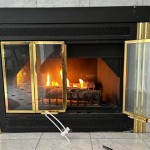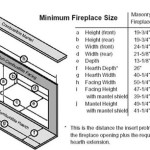Anatomy of a Fireplace Mantel
The fireplace mantel, a prominent architectural feature surrounding a fireplace, serves both functional and aesthetic purposes. It provides a decorative frame for the firebox opening and offers a shelf for displaying decorative items. Understanding the anatomy of a fireplace mantel involves identifying its key components, construction methods, and various design styles. The following explores these facets in detail.
Essential Components of a Fireplace Mantel
A typical fireplace mantel comprises several distinct elements. The
mantel shelf
, also known as the mantel top, is the horizontal surface situated above the firebox opening. It provides a platform for displaying objects such as photographs, vases, and artwork. The shelf's depth and length significantly impact the overall visual appeal and functional utility of the mantel.Below the mantel shelf resides the
mantel surround
, encompassing the vertical and often decorative elements flanking the firebox opening. The surround typically consists of two verticalpilasters
or side panels and a horizontalheader
or frieze connecting the pilasters. These elements frame the firebox and contribute significantly to the mantel's overall style and character.The
legs
or supports are vertical structures that hold up the mantel shelf. They can be simple, straight pieces of wood or elaborately carved columns. The style of the legs often dictates the overall aesthetic of the mantel, influencing whether it appears traditional, modern, or rustic. The space between the legs is known as thefirebox facing
, this is the visible section of the wall around the firebox opening. It can be made of brick, stone, tile, or other fire-resistant materials. This area is crucial in ensuring the safety of your fireplace hearth.Often, a
hearth
extends outward from the firebox opening. While technically not part of the mantel itself, the hearth is an integral component of the fireplace assembly and contributes to its overall appearance. It is typically constructed of non-combustible materials like brick, stone, or tile, providing a safe surface for embers and ash to fall upon.Construction and Materials
The construction of a fireplace mantel involves careful craftsmanship and adherence to building codes. The materials used in constructing the mantel influence its durability, aesthetics, and fire resistance. Wood is a common material for mantels, offering versatility in design and ease of construction. Various types of wood, such as pine, oak, maple, and cherry, can be used, each possessing unique grain patterns and characteristics. When wood is used, adherence to fire safety regulations is crucial, ensuring adequate clearance between the wood and the firebox opening to prevent combustion. The wood should be treated to make it more fire-resistant.
Stone is another popular material for fireplace mantels, prized for its durability, fire resistance, and natural beauty. Stone mantels can be crafted from various types of stone, including marble, granite, limestone, and slate. The weight of stone mantels necessitates careful structural consideration during installation, ensuring adequate support and anchoring to the surrounding wall. Stone mantels often lend a sense of grandeur and permanence to a room.
Brick is a versatile and cost-effective material commonly used for fireplace surrounds and hearths. Brick provides excellent fire resistance and can be painted or stained to achieve various aesthetic effects. Brick mantels often evoke a rustic or traditional style, complementing a wide range of architectural designs. Brick also has excellent heat retention capabilities.
In modern designs, metal is increasingly used in mantel construction, often in combination with other materials like wood or glass. Metal mantels can be fabricated from steel, aluminum, or cast iron, offering sleek lines and contemporary aesthetics. Metal is inherently fire-resistant and can be powder-coated or painted to achieve various finishes. Metal can also be used as accents or decorative elements within a mantel.
Design Styles and Aesthetic Considerations
Fireplace mantels are available in a wide array of design styles, reflecting different historical periods and architectural preferences. The choice of mantel style can significantly impact the overall ambiance of a room, complementing or contrasting with existing design elements.
Traditional mantels
often feature ornate carvings, intricate moldings, and classical architectural details. These mantels typically incorporate elements such as fluted pilasters, dentil molding, and decorative corbels. Traditional mantels often evoke a sense of formality and elegance, complementing period homes and formal living spaces.Modern mantels
tend to be characterized by clean lines, minimalist designs, and a focus on functionality. These mantels often incorporate simple geometric shapes, smooth surfaces, and a lack of ornamentation. Modern mantels often prioritize simplicity and understated elegance, complementing contemporary homes and minimalist interiors.Rustic mantels
often feature rough-hewn wood, exposed brick, and natural stone finishes. These mantels evoke a sense of warmth and informality, complementing log cabins, farmhouses, and country-style homes. Rustic mantels often incorporate reclaimed materials and salvaged elements, adding to their unique character.Transitional mantels
bridge the gap between traditional and modern styles, blending elements of both to create a balanced and harmonious aesthetic. These mantels often incorporate clean lines and simple forms with subtle ornamentation and traditional details. Transitional mantels offer versatility and can complement a wide range of interior design styles.The selection of a fireplace mantel should consider the size and proportions of the room, the existing architectural style, and the desired aesthetic effect. A well-chosen mantel can serve as a focal point in a room, enhancing its visual appeal and adding value to the home. Considerations of fire safety and adherence to building codes are paramount during the installation process.

Fireplace Anatomy

Result For Fireplace Parts Shiplap Feature Wall Mantel Surrounds Remodel

What Are The Components Of A Fireplace Five Ways Fires

Fireplace Mantel Surround With Granite Hearth Monk S In

How To Update The Look Of Your Fireplace

Fireplace Terms Drawings Yahoo Search Results Home Surrounds Diy
What Is The Ledge In Front Of A Fireplace Called Quora

Fireplace Anatomy Ryan Smith Antique Fireplaces

Chimney Anatomy Fireplace And Professionals

All About Customizing Your Fireplace Old World Stoneworks
Related Posts








